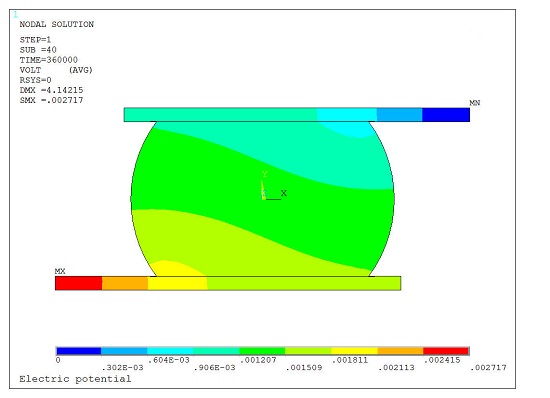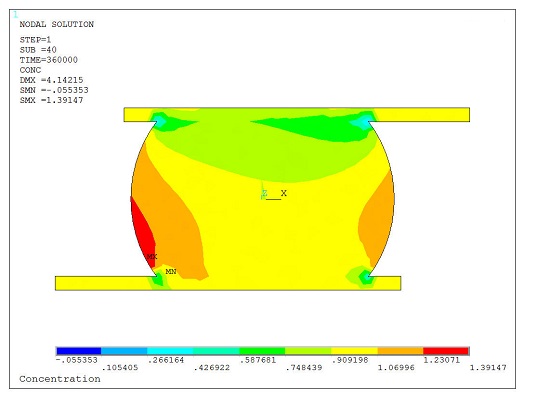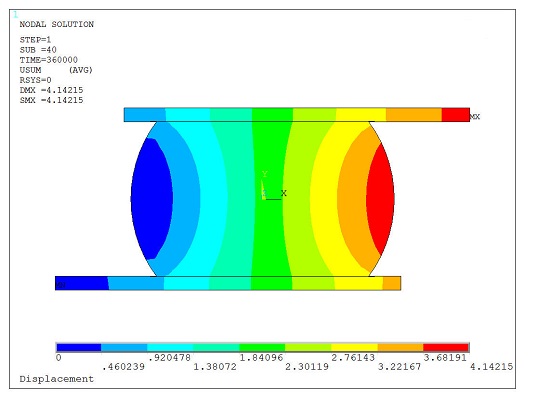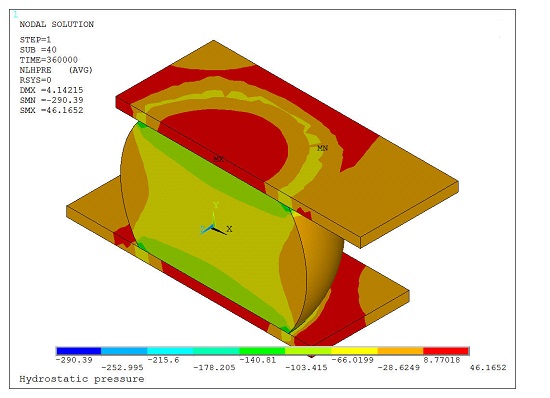Use a structural-electric-diffusion analysis to perform diffusion stress analysis, hydrostatic stress migration analysis, and electromigration analysis. Applications include development of stress during the process of electromigration in metallic interconnects.
The following related topics are available:
Table 2.37: Elements Used in Structural-Electric-Diffusion Analyses summarizes the elements that you can use to perform a coupled thermal-electric-diffusion analysis. For detailed descriptions of the elements and their characteristics (degrees of freedom, KEYOPT options, inputs and outputs, etc.), see the Element Reference.
For a coupled structural-electric-diffusion analysis, you need to select the UX, UY, UZ, VOLT and CONC element degrees of freedom by setting KEYOPT(1) to 100101 for the coupled-field elements.
The structural-electric-diffusion KEYOPT settings also make large-deflection, stress-stiffening, and prestress effects available (NLGEOM and PSTRES). (See Structures with Geometric Nonlinearities in the Theory Reference for more information about these capabilities.)
Table 2.37: Elements Used in Structural-Electric-Diffusion Analyses
| Elements | Effects | Analysis Types |
|---|---|---|
|
PLANE222 - 4-Node Coupled-Field Quadrilateral PLANE223 - 8-Node Coupled-Field Quadrilateral SOLID225 - 8-Node Coupled-Field Hexahedral SOLID226 - 20-Node Coupled-Field Hexahedral SOLID227 - 10-Node Coupled-Field Tetrahedral |
Diffusion strain Hydrostatic stress migration[a] Electromigration Piezoresistivity |
Static Full Transient |
To perform a structural-electric-diffusion analysis, you need to follow the steps outlined in Performing a Structural-Diffusion Analysis, Performing an Electric-Diffusion Analysis, andPiezoresistive Analysis.
This example demonstrates a transient structural-electric-diffusion analysis of a solder joint. Note that the geometric and material properties are input in the μMKSV system of units. For more information on units, see System of Units.
The following topics are available:
An SAC (SnAgCu) solder ball is sandwiched between two copper strips. A half symmetry model of the solder ball and the strips is discretized using the structural-electric-diffusion analysis option (KEYOPT(1) = 100101) of the SOLID227 coupled-field element. A step current load I = 2.85 A is applied to the bottom strip; the top strip is grounded. A uniform temperature of 200 °C is applied to the ball. The initial normalized concentration of atoms is set to 1.
A transient analysis is performed for 100 hours to determine the evolution of atomic concentration over time as the atoms (ions) migrate under the gradient of hydrostatic stress (stress-migration), the electric field (electromigration) and the gradient of concentration (diffusion).
The material parameters for stress-migration and electromigration are specified using the migration model (TB,MIGR). Initially, only the thermal expansion determines the stress distribution. After the atomic concentration changes from the initial equilibrium value, diffusion expansion contributes to the stress state and thus to stress-migration (backstress).
The numerical results at the end of the simulation are shown in the following figures:
The command text below demonstrates the problem input. All text prefaced with an exclamation point (!) is a comment.
/title, Electromigration and stress migration in a solder joint
/pnum,volu,1
/prep7
! Model (sizes in um)
wprota,,-90
sphere,380,,0,180
wprota,,180
wpoffs,,,225
vsbw,1
numcmp,volu
vdele,1,,,1
numcmp,volu
wpoffs,,,-450
vsbw,1
numcmp,volu
vdele,1
numcmp,volu
block,-400,600,-400,0,-40,0
wpoffs,,,450
block,-600,400,-400,0,0,40
vglue,all
numcmp,volu
vplot
!
! Constants and material coefficients in uMKS system of units
!
kB=1.3806488e-23*1.e12 ! Boltzmann constant, pJ/K
kB_eV=8.6173324e-5 ! Boltzmann constant, eV/K
! Copper (mat 1)
et,1,solid227,100101 ! structural-electric-diffusion
mp,rsvx,1,2.38e-8*1e-6 ! electric resistivity, TOhm*um @ 200 C
mp,dxx,1,7.8e-5*1e12 ! pre-exponential diffusivity, (um)^2/s
Qa=210e3 ! activation energy, J/(K*mol)
R=8.31445 ! universal gas constant, J/(K*mol)
V1=1.182e-29*1e18 ! atomic volume, um^3
Z1=-4 ! charge number
tb,migr,1 ! migration model for Cu
tbdata,1,Qa/R ! diffusivity
tbdata,2,V1/kB ! hydrostatic stress migration
tbdata,4,Z1/kB_eV ! electromigration
mp,ex,1,127.7e9*1e-6 ! Young's modulus, MPa
mp,prxy,1,0.31 ! Poisson's ratio
mp,cref,1,1 ! reference concentration
mp,betx,1,1e-5 ! coefficient of diffusion expansion
! for backstress calculation
tref,25 ! reference temperature and
mp,alpx,1,17.1e-6 ! coefficient of thermal expansion 1/deg
! for thermal strain calculation
! Solder - SAC (mat 2)
et,2,solid227,100101
mp,rsvx,2,20.75e-8*1e-6 ! electric resistivity @ 200 degC, TOhm*um
mp,dxx,2,4.1e-5*1e12 ! pre-exponential diffusivity, (um)^2/s
mp,ex,2,26.2e9*1e-6 ! Young's modulus
mp,prxy,2,0.35 ! Poisson's ratio
V2=2.71e-29*1e18 ! atomic volume, um^3
mp,cref,2,1 ! reference normalized concentration
mp,betx,2,1e-5 ! coefficient of diffusion expansion
! for backstress calculation
mp,alpx,2,23e-6 ! coefficient of thermal expansion, 1/deg
Ea=0.8 ! activation energy, eV
Z2=-23 ! charge number
tb,migr,2 ! migration model for SAC solder joint
tbdata,1,Ea/kB_eV ! diffusivity
tbdata,2,V2/kB ! hydrostatic stress migration
tbdata,4,Z2/kB_eV ! electromigration
type,1
mat,1
esize,40
vmesh,2,3
type,2
mat,2
vmesh,1
nsel,s,loc,x,600 ! top electrode
d,all,volt,0
nsel,s,loc,x,-600 ! bottom electrode
cp,1,volt,all
nd=ndnext(0)
allsel
! Loads
bf,all,temp,200 ! temperature, degC
toffst,273 ! temperature offset from absolute zero to zero, degC
f,nd,amps,2.85e12/2 ! total current for half-model, pA
nsel,s,loc,y,-265 ! structural constraints
nsel,a,loc,y,265
d,all,uy,0
nsel,s,loc,x,-600
d,all,ux,0
nsel,s,loc,z,0
d,all,uz,0
nsel,all
finish
/solu
antype,trans ! transient analysis
ic,all,conc,1 ! initial normalized concentration
time,3.6e5 ! simulation time, s (100 hours)
nsubst,40
kbc,1
autots,off
nlgeom,on ! large-deflection effects enabled
outres,all,all
solve
finish
/post1
set,last,last
/title, Electric potential
plnsol,volt
/title, Concentration
plnsol,conc
/title, Displacement
plnsol,u,sum
/title, Hydrostatic pressure
plnsol,nl,hpres
finish






